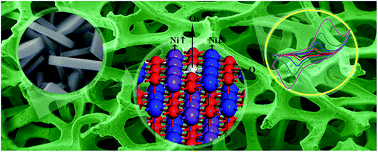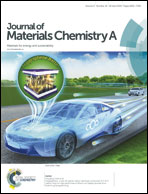O-Vacancy-enriched NiO hexagonal platelets fabricated on Ni foam as a self-supported electrode for extraordinary pseudocapacitance†
Abstract
To enhance the capacitive property of NiO-based electrodes, O-vacancy-enriched NiO hexagonal platelets have been fabricated in situ on an Ni foam current collector by a facile hydrothermal treatment of Ni foam in a H2O2 aqueous solution and subsequent calcination in N2 atmosphere. Due to the self-grown nature and the abundant oxygen vacancies, the as-prepared self-supported NiO electrode showed extraordinary pseudocapacitance. The specific capacitance of the as-prepared NiO electroactive materials was 2495 F g−1 at a scan rate of 1 mV s−1 (∼97% of the theoretical value of NiO) and the capacitance retention was higher than 80% when the current density increased from 0.5 to 10 A g−1. DFT computational studies proved the vital role of oxygen vacancies in increasing the conductivity, electrochemical active sites and surface reactivity, which substantially account for the significantly high specific capacitance and rate capability. This study may further broaden the applications of NiO-based materials and boost the research on oxygen nonstoichiometry.



 Please wait while we load your content...
Please wait while we load your content...